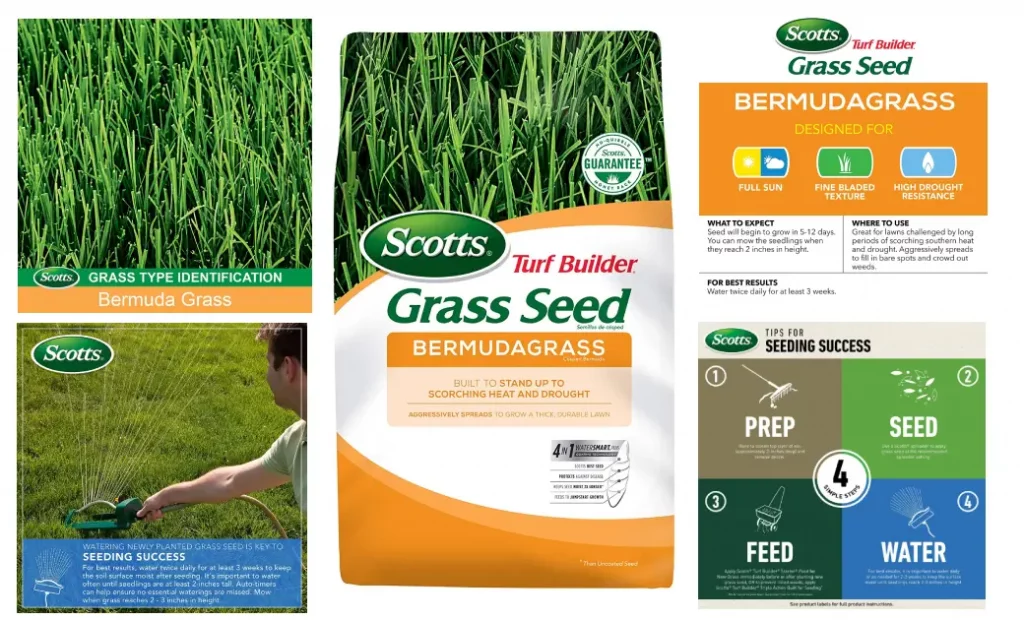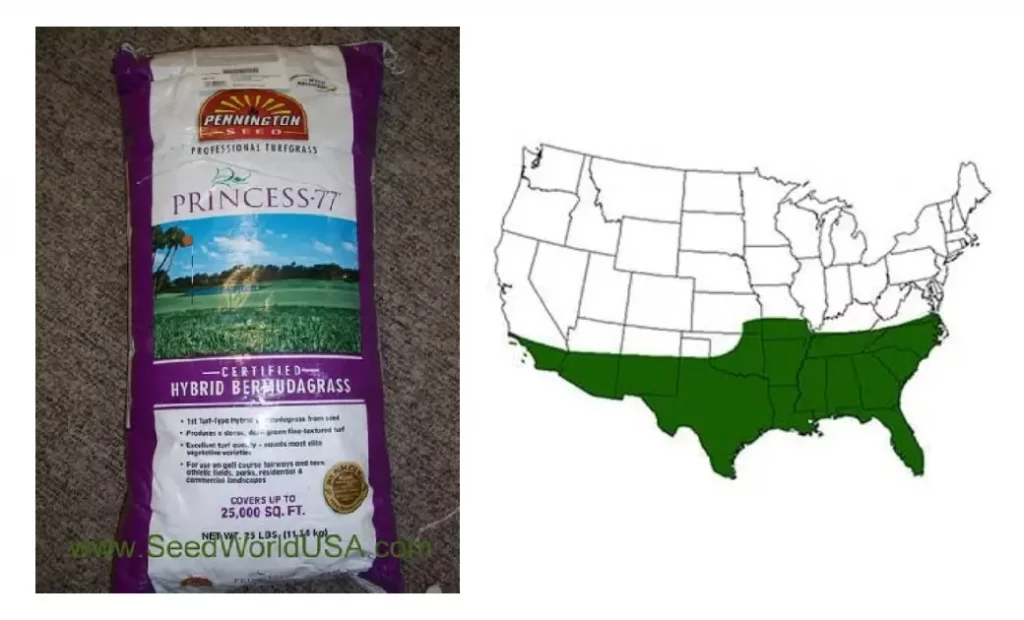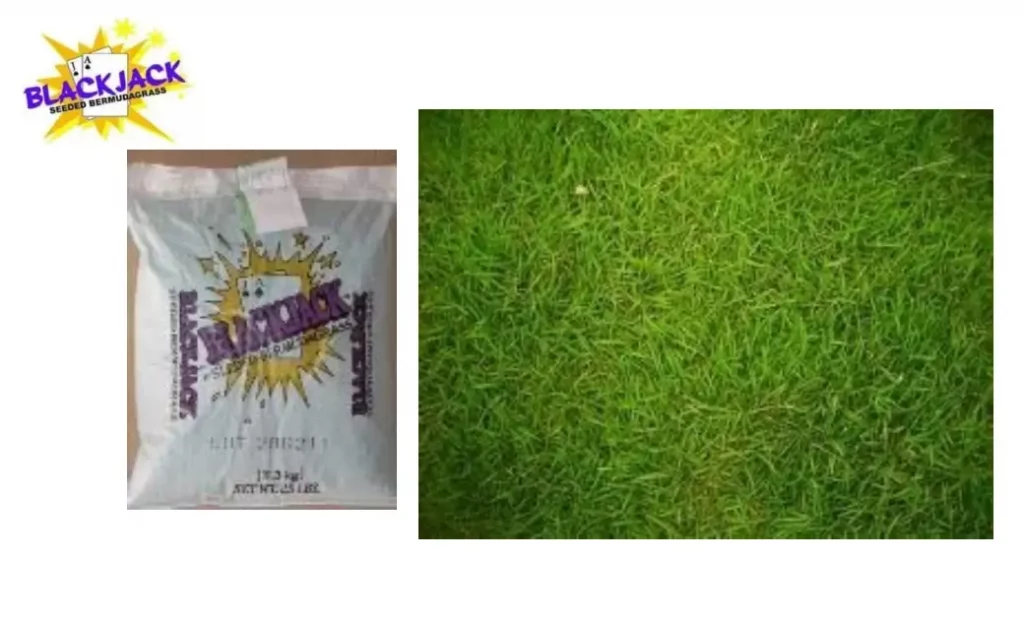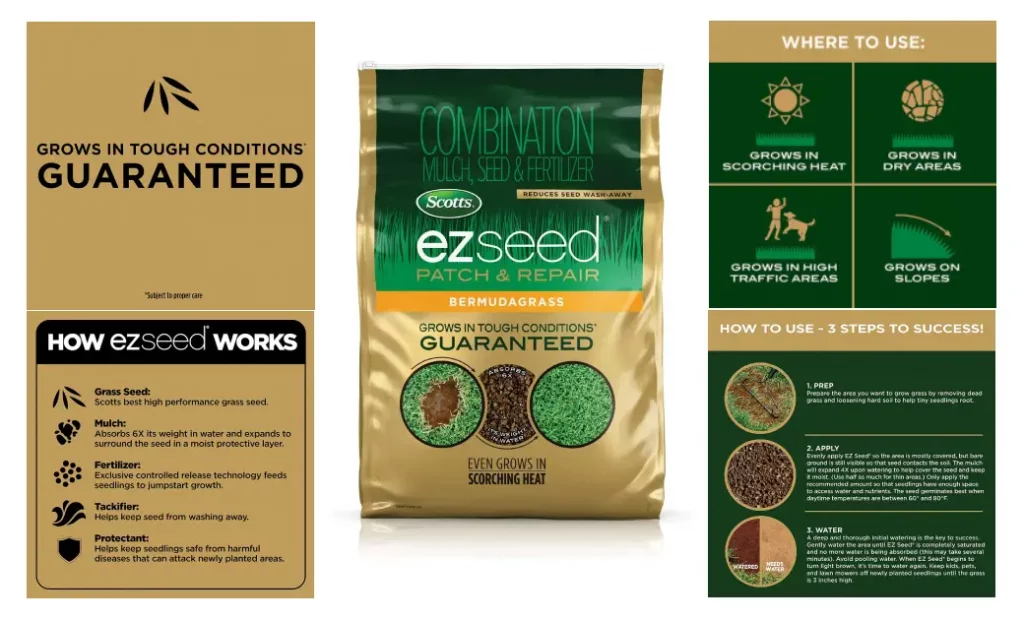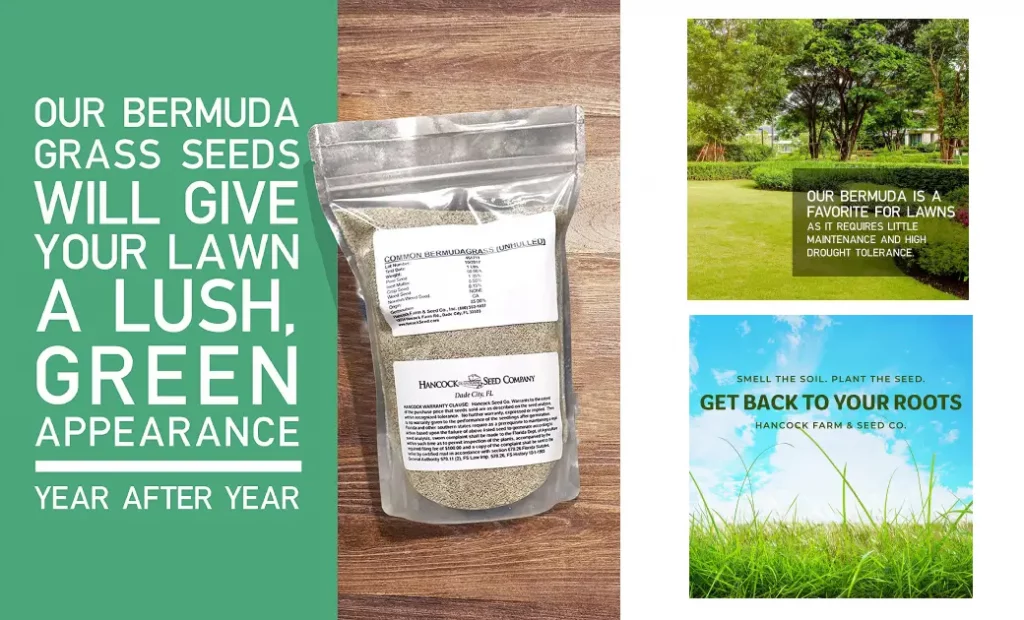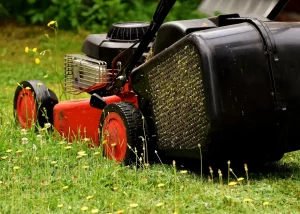Bermuda grass is a good choice for a turfgrass, and you need a lot of it to make a lawn. Bermuda grass is tough and can take a lot of abuse.
This grass is great for creating a low-maintenance, thick, and uniform lawn–perfect for home lawns, golf courses, parks, and athletic fields. With so many different types of seed available, choosing the right one for your lawn can be tough.
When it comes to seeding new grass, there are a few things you’ll want to take into account. Here’s a look at some of the best Bermuda grass seed options, as well as some tips on getting a lush, low-maintenance lawn.
Popular Bermuda Grass Varieties
[slide-anything id=”2117″]
There are loads of different Bermuda grass types out there. They all fall into two broad groupings: seeded and hybrid. Seeded Bermuda grass grows from seeds, obviously. Hybrid Bermuda grass has been purposefully produced and is more disease-resilient than its seeded brothers.
No #01 Blackjack:
This seeded Bermuda grass variety is ideal for your lawn if you’re looking for luscious, thick growth. It’s perfect for warm areas and can tolerate cold months easily too. So if you want a natural-looking green carpet for your garden, this plant is your best choice!
No #02 Yuma:
This seeded Bermuda grass will give you an amazing emerald color when fully mature. It’s the perfect choice for high-end golf courses. Yuma can handle extreme summer heat, doesn’t need a lot of watering, and grows slowly, so you won’t have to mow and prune it very often.
No #03 Oasis Blend:
This Bermuda grass type, on the other hand, grows extremely fast. Plus, it’s exceptionally resistant to pedestrian activity and easy to care for. La Prima is another Bermuda type that’s just as non-demanding and fast-growing.
No #04 Sahara:
If you’re looking for a grass that can handle the heat, Sahara is a great option. It’s perfect for hot and humid areas, and can take a lot of abuse from the sun. Plus, it’s fairly inexpensive. The Sahara is also low-maintenance and resistant to even the craziest activity that your kids may do outdoors.
No #05 Princess 77:
Princess 77 is a Bermuda grass type that is known for its fragility and delicateness. However, it is also very beautiful and stylish. If you are looking to add a touch of sophisticated elegance to your home, Princess 77 may be the right choice for you.
Two Broad Categorizations of Bermuda Grass
The different types of Bermuda grass usually have a short germination period because the natural protective coating on the seeds is removed when they are planted. Hulled seeds usually sprout faster than un-hulled ones.
Bermuda grass seed is a favorite among homeowners and lawn-care experts, as it thrives on varied soil types. Additionally, Bermuda grass is drought-resistant as well as being one of the most popular warm-season grass types you can pick.
There are two primary types of Bermuda grass: Hybrid Bermuda and Common Bermuda. Hybrid Bermuda grass includes Tif varieties, while common Bermuda grass typically comprises seeded varieties. Let’s examine each of these two types of Bermuda grass varieties in more detail.
Common Bermuda grass
This variety of Bermuda grass is also called seeded Bermuda grass. It has a light-green hue with a rough texture. Although it has a lower shoot density than hybrid varieties, common Bermuda grass has higher nutritional value, making it more suitable for making forage and hay for livestock.
Bermuda grass is a tough plant that can withstand a lot of foot traffic, making it great for yards and public parks. However, the common variety of Bermuda grass is not ideal for lawns, which is where the improved common Bermuda seeded varieties come in.
Cheaper to maintain and able to thrive in high-traffic areas, these improved varieties of grass are a great alternative to Hybrid Bermuda. Perfect for lawns, public parks, and even sports fields, they are a cost-effective way to keep your grounds looking green.
We Recommended This Common Bermuda Grass Seed:
Scotts Turf Builder Grass Seed for Bermudagrass
If you’re looking to give your lawn a little boost, Scotts Turf Builder Grass Seed Bermudagrass is a great option, especially for those in southern climates that experience long periods of heat and drought. This seed mix is great for filling in bare spots and crowding out weeds.
WaterSmart PLUS Coating helps each seed absorb twice as much water as uncoated seed, and also provides essential nutrients and protection from disease.
This turfgrass is perfect for areas that get a lot of sun and foot traffic. It’s also resistant to drought conditions. It will quickly spread to fill in any bare spots and crowd out weeds. You’re guaranteed to get thicker, greener grass that grows quickly.
Product Specification
If you’re looking to add some new life to your lawn, our seeded products are a great option. A 5-pound bag of seed will cover 5,000 square feet if you’re adding it to an existing lawn, or 1,665 square feet if you’re starting from scratch. Germination time is usually between 5 and 12 days.
Pros
The blades on this seed are really fine, which is great. They also germinate really quickly, which is awesome. The coating on the seed is really beneficial too- it jump-starts and protects the seedlings.
Cons
The downsides are that it’s not marketed as being weed-free.
Hybrid Bermuda grass
This type of grass is also known as a ‘sterile vegetative hybrid’. It’s a cross between two different grass species – common Bermuda and African Bermuda (Cynodon transvaalensis). Hybrid Bermuda grass can only be grown using vegetative methods like sod, plugs or sprigging, as it doesn’t produce seeds.
Below we explained each of these vegetative methods:
- Sods: This is where patches of grass are extracted from an existing turf and installed/planted in the desired area.
- Plugs: Seedlings are grown in trays and then replanted in the desired bedding.
- Sprigging: Sprigging is a process of planting grass by using sprigs, or small sections of grass.
Exceptions
There are a few exceptions to the seeded and hybrid Bermuda grass types, including ‘Texturf 10’ and ‘Princess.’ The former, for example, cannot produce seeds if isolated, but will do so if there is pollen from any other type of Bermuda grass nearby.
We Recommended This Princess 77 Hybrid Bermuda Grass Seeds
The “Princess” Bermuda grass is a hybrid that produces seeds, unlike other hybrids. However, it can be distinguished from other seeded varieties by its darker color and softer texture.
Hybrid Bermuda grasses are created to have the best qualities of common Bermuda grass. Arden 15 Hybrid Bermuda Grass Seed is a great example of this type of improvement.
The Arden 15 is the next generation of Princess 77, which is widely considered to be the first fine-textured hybrid Bermuda grass. It has a lot of the same great qualities as the Princess 77 variety, like being able to handle lots of sun and drought, being really dense and having great coverage, being a beautiful dark green, and having a great texture.
The Arden 15 grass seed is really great for cold tolerance and grow-in speed. It creates a very uniform turf, which is perfect for lawns, golf courses, and parks.
Product Specification
This hybrid grass seed is perfect for new lawn coverage. One pound will cover approximately 500 square feet, and it will germinate in 7 to 14 days.
Pros
The main benefits of this grass are that it’s more tolerant to cold weather and grows quickly. It also has a nice, fine texture and deep green color.
Cons
Pricey is one downside.
Best Bermuda grass for golf greens?
I really like Blackjack Bermuda for golf greens because it is a hardy, fast-healing grass variety.
Blackjack Seeded Bermuda Grass Seed
Over the years, Bermuda grass has become the go-to option for golf courses among turf professionals. This is mostly due to its capability to withstand drought and wear.
There are a few different types of Bermuda grass that could be a good option for you, depending on what you’re looking for. If you’re establishing a new lawn, you might want to consider one of the following types of Bermuda grass. Or, if you’re the maintenance manager at a local golf club, you might want to keep these types of Bermuda grass in mind.
Blackjack Bermuda grass is a popular type of grass that is known for its dense coverage. It is a good choice for areas with frequent foot traffic.
Blackjack Bermuda grass is a popular choice for lawns because it stays dark green and vibrant during the summer months.
Expect the Blackjack Bermuda grass to be thick and full, like a carpet. It’s tolerant to shade and drought, and does well in cold weather. The seeding success and germination rate is high, and the texture is very fine, making it resistant to drought.
This Bermuda grass is perfect for well-drained soil. It’s a great shade tolerant grass that does best in full sunlight. If you’re thinking of seeding your lawn with Blackjack Bermuda grass, do it when the soil temperature is around 65°F, at a rate of 2-3 lbs per 1,000 sq. feet.
Best Bermuda Grass for Home Lawns
When it comes to lawns, the two most important decision-making considerations should be aesthetic appearance and the ability to resist lawn diseases. But before you plant Bermuda grass of any type, be sure to have good irrigation in place.
So, basically, hybrid Bermuda grass is the best since it looks like common Bermuda grass, but doesn’t get disease as easily. The only downside to Bermuda grass is that it requires more lawn care to keep your backyard looking good. Here are some of the best Bermuda grasses for your home – all hybrid varieties – that will do well on your lawn.
TifWay 419
I always use the Tiflawn blend for my home lawn. It grows quickly and gets really thick. It’s perfect for dogs or areas with a lot of foot traffic because it’s really tough and comes back quickly. Tifway 419 is also very durable with disease resistance you can mow closer to the ground.
TifSport
TifSport Bermuda grass was released in 1997. It is known for its superior turf texture and density, as well as its cold tolerance and winter hardiness. These characteristics make it a desirable choice for many lawns and landscapes. TifSport turfs can only be produced by vegetative propagation, as it doesn’t produce seeds.
Tifway II
Tifway II is an improved variety of Tifway Bermuda grass, exhibiting greater tolerance to frost and nematode damage. It is also denser in terms of growth, creating a more robust lawn.
TifGrand
This Bermuda grass hybrid is ideal for lawns because it can maintain its attractive leaf appearance even when soil conditions deteriorate. TifGrand Bermuda grass is known to better retain its lush green leaf-blade hue, even under insufficient nitrogen conditions.
This Bermuda grass hybrid is great because it doesn’t produce pollen and is more disease-resistant than most common Bermuda grasses. Plus, it grows relatively faster and is highly shade-tolerant.
If your lawn is TifGrand, experts recommend mowing it when it reaches a height of about two inches. TifGrand is also known by its commercial name, PP21017.
Our Other Top Picks
Grass seeds are easy to plant and will grow reliably. Sow a thick and attractive lawn with the best Bermuda grass seed products.
Scotts EZ Seed Patch and Repair Bermudagrass
Several factors can cause a patchy lawn, including disease, insects, pet urine, and foot traffic. While they are unsightly, patches can be fixed. Scotts EZ Seed Patch and Repair Bermudagrass is a convenient solution for those annoying brown patches.
This grass seed is designed to germinate and grow in difficult environments, including hot and arid conditions, sloped terrain, and areas with high levels of foot traffic. It contains a mix of Bermuda grass seed, mulch, fertilizer, tackifier, and a protectant.
The fertilizer gives the seedling a boost to grow, while also protecting it from disease. This allows the seed to grow in areas that were previously damaged, filling in with fresh, verdant grass.
Specification
This product is a patch repair that covers 20 pounds of seed for 445 square feet. Germination time is 10 to 30 days.
Pros
The grass is tough and can grow in difficult conditions. It will fill in brown patches within a few weeks. The grass contains mulch, fertilizer, a tackifier, and a protectant.
Cons
Patching your lawn with this won’t cover the entire thing.
Hancock Seed Co. Common Bermuda Grass Seeds
Hancock Seed Company has been one of the best seed-producing companies for over 40 years. Almost all of the seeds are being grown by the company itself. Moreover, the packaging and shipping are also done by Hancock Farm, which proves that the roots are always fresh and meet the highest standards.
The Hancock grass seeds are my personal favorite. If you like gardening as much as I do, you’ll love it. It’s one of the best Bermuda grass seeds I’ve ever tried.
This grass is great for all kinds of things – not just growing a drought-resistant lawn, but also for landscaping applications, erosion control, and even for pasture. I’ve even experimented a bit and grew the grass in a sandy soil type, and it turned out great.
Pros
The advantages of this plant are that it’s extremely drought-resistant, has a nice green leaf texture and color, and is low-maintenance. It can even grow in poor-quality soil types!
Cons
The only downside is that it can sometimes get a little brown.
Outsidepride Full House Bermuda Grass Seed
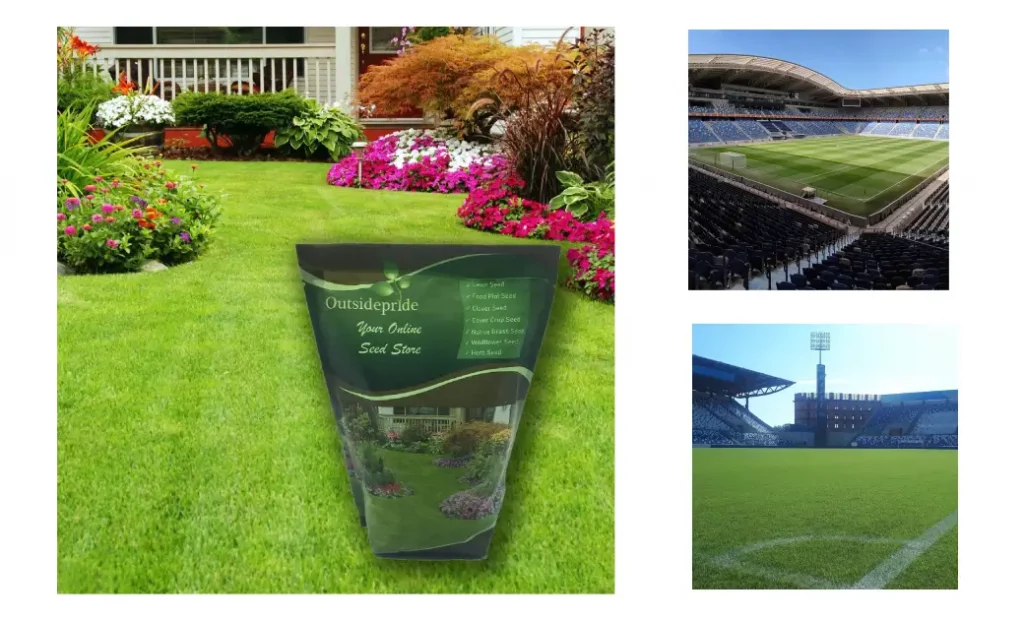
Hybrid Bermuda grasses are created to combine the best qualities of common Bermuda grass. Arden 15 Hybrid Bermuda Grass Seed is a great example of this type of improvement.
Arden 15 is the next step up from Princess 77, which many people believe to be the first fine-textured hybrid Bermuda grass that was available in seed form.
The Princess 77 variety is pretty great, and this one’s got a lot of the same going for it. It’s really tolerant of sun and drought, and it’s dense and covers well. Plus, the color is a deep, gorgeous green, and the texture is really fine.
The Arden 15 grass seed is way better when it comes to cold tolerance and grow-in speed than the Princess 77 variety. You’ll get a much more uniform turf too, which is perfect for lawns, golf courses, and parks.
Specification
This seed is a hybrid that will cover an area of 500 square feet with just one pound. You can expect germination within 7 to 14 days.
Pros
The advantages of this grass are that it is more tolerant to cold temperatures and has a fast growth rate. The fine texture and deep green color of the grass make it an attractive option for landscaping.
Cons
Pricey
Pennington Seed 1 lb Bermuda Grass Seed
This Bermuda grass seed from Pennington is a no-frills grass seed blend. Even though it doesn’t have fertilizer like its Smart Seed line, this seed still has Pennington’s Penkoted technology.
These Penkoted seeds contain a growth stimulant to help the plant establish quickly during its vulnerable growth period. Once the seedlings are established, they’ll grow into a thick, durable, self-spread, and self-repairing lawn that’s tolerant to both heat and drought.
This grass is ideal for sunny and high-traffic lawns. It has a moderately fine, turf-type texture that looks great and is also durable under foot traffic, pets, and playing children, making this seed an ideal choice for busy lawns.
Specification
This grass seed is best for adding to an existing lawn since it can cover 1,000 square feet with just 1 pound. It can take anywhere from 7 to 21 days for the seed to germinate.
Pros
The pros of this soil are that it’s got a pretty decent texture – not too sandy, not too clay-ey. It’s also pretty good at resisting wear and tear, and germinates pretty quickly.
Cons
No-frills option.
Consider When Choosing the Best Bermuda Grass Seed
When seeding a new lawn, there are several factors to consider, such as the type of grass seed, the climate, the location of the lawn, and how the lawn will be used. The type of grass seed you choose should be based on your desired germination time, color, and texture. The climate and location of your lawn will determine the type of grass seed that will work best. If you live in a warm climate, Bermuda grass seed is a good option.
No #01 Seed Availability
If you’ve ever had a product recommended to you only to find out it’s only available online, you know how important availability is. It’s especially important if it’s a product you use and rebuy often.
If you find yourself needing Bermuda grass seed more often than just once a month, don’t worry about availability. You should be able to find it easily, whether you need it for multiple projects or to patch up an existing layer.
This can be a challenge if the only place you can buy grass seed is from one seller or store. But if you’re willing to plan your purchases and be patient, it doesn’t have to be a deal-breaker.
If you’re the type of person who often runs out of grass seed and needs it quickly, you might want to make sure that the seed you choose is available from a variety of different places.
No #02 Geographic Zone
Grasses generally come in two types: those that prefer cooler weather, and those that prefer warmer weather. Bermuda grass is one of the most common warm-weather grasses. As their name suggests, warm-weather grasses can take the heat, making them ideal for locations in the southern United States.
Bermuda grass can handle the heat, making it a great choice for hot, humid, and even arid climates. Those living in states north of these should look into a different grass type, like fescue grass or Kentucky bluegrass.
Bermuda grass doesn’t do well in cooler temperatures, so it can be tough to keep a Bermuda grass lawn in a cooler climate. It can also be costly.
No #03 Germination Time
The time it takes for Bermuda grass to sprout up from seed form depends on a few different conditions. The first factor is whether the seeds have their hulls still intact or not; if they do, it’ll take longer for them to germinate. The second factor is the state of your soil – is it moist, dry, rich, etc. – which can also affect germination time.
Most Bermuda grass needs the soil to be at least 65 degrees Fahrenheit before planting. This temperature should stay steady for a little while before planting happens.
The ideal pH for planting Bermuda grass is around 7, but it can also do well in soil with a pH of 5.8 or 6. Make sure to loosen and rake the soil before planting, and remove any debris.
No #04 Color and Texture
Bermuda grass is a great choice for your lawn if you’re looking to add some instant curb appeal. It’s rich green color and medium-to-fine texture make it a popular choice for residential lawns. Not to mention, it feels great to walk and play on.
The color and texture of your grass can vary depending on the type of grass and the brand of grass seed you use. Since there are many different types of Bermuda grass seeds available, it can be hard to tell what the exact color and texture will be.
If you want to know how the grass will look once it’s cultivated, read the product descriptions and consumer reviews. Keep in mind that Bermuda grass turns brown and goes dormant in cooler weather. If you’re wondering how to get Bermuda grass to fill in or cover brown areas, you might want to try overseeding your lawn.
One way to achieve a greener lawn year-round is to overseed your Bermuda grass lawn with another type of grass, like ryegrass. If you take good care of your Bermuda grass lawn, it will reward you with a lush green color in the summer.
No #05 Amount of Shade
Bermuda grass is a tough grass that can handle poor soil and bounce back quickly from damage. But there’s one thing it really needs: sunlight. This natural heat- and drought-resistant grass does best in sunny areas.
You’ll want to consider how much sun your desired planting area gets during the day. Bermuda grass grows best in areas that get at least 4 hours of full, direct sunlight daily, but 8 hours is usually better. Planting Bermuda grass seeds in a shady area probably won’t give you the results you’re looking for.
For shady areas, consider a different grass type or a Bermuda grass blend that incorporates shade-tolerant grasses. Shade-tolerant grasses can help fill in areas where Bermuda grasses may not do as well.
No #06 Wear and tear
Some Bermuda grass varieties are softer and more delicate than others, and can’t handle as much foot traffic. If you want your grass to last, choose a variety that’s more resilient to heavy foot traffic.
There are other, more rugged and durable, grass species that can withstand children, soccer practice, and large gatherings. Even still, there are a handful of even more hardy Bermuda grasses that are best used in public areas such as sports fields.
How to Seed Bermuda Grass
If your lawn is looking a little out of control, starting a new Bermuda lawn from scratch may be the best option. Below, you will find the simple steps to begin a beautiful new Bermuda lawn from seed.
Required Soil Conditions
The best time to plant Bermuda grass seed is in late spring or early summer when soil temperatures are above 65 degrees (F). However, for the soil temperature to be in that range, the air temperature should be in the range of 85 to 130 degrees (F).
When planting Bermuda grass, the soil temperature is important to keep in mind. You can measure it by inserting a probe thermometer a few inches into the soil.
If the temperature drops below 60, the growth of this grass slows down and can even stop. The optimum soil temperature for seeding is between 75 and 85 degrees Fahrenheit.
Under ideal conditions, Bermuda grass seeds can germinate in 7-14 days and fully grow within 60-90 days. If the seeds have had their hulls removed (i.e. the skin), germination is usually faster at 5-10 days.
If the conditions aren’t ideal, it might take longer for both types of seeds to germinate. Bermuda grass needs a lot of water during germination, and the soil needs to be kept moist.
It’s important to get a soil test done to find the ideal pH level for your soil, which should be between 5.6 and 7. You can get this test done at your local University’s cooperative extension. If the soil is found to be more acidic, you should mix lime into it. If the soil is found to be too alkaline, use sulfur to get the right pH level.
You shouldn’t apply any herbicides or fertilizers on the soil at least 2-3 months before seeding and 2-3 months after seeding.
You’re likely to have problems with your Bermuda seedlings if you plant them with ryegrass or other grasses. The seedlings won’t survive if they’re competing with weeds. Turf experts generally recommend against planting seedlings with ryegrass or other grasses.
You’re likely to have problems with your Bermuda seedlings if you plant them with ryegrass or other grasses. The seedlings won’t survive if they’re competing with weeds. Turf experts generally recommend against planting seedlings with ryegrass or other grasses.
The right seasons for seeding
You shouldn’t plant Bermuda grass in late fall. Even if you plant it in early spring, there might be some negative impacts during the germination process.
This grass shouldn’t be planted too close to when the first frost is expected in northern areas (90 days or less), or in southern areas (60 days or less).
Other risks of planting Bermuda grass late in the year include its inability to store enough food reserves in its roots to last through the winter dormancy period.
The late-seeded grass starves and dies because it doesn’t get enough nutrients and water during the winter dormancy period.
Bermuda grass can be seeded or planted around the year in areas with warm temperatures, such as Hawaii, the Caribbean, or South Florida.
Bermuda grass is a popular choice for lawns because it’s relatively inexpensive and can cover a full lawn in one year if it’s properly seeded.
In warmer months, grass grows a little in colder climates too. When it’s hot out, seeded Bermuda grass turns brown. In tropical countries, Bermuda grass usually stays a beautiful green color if there’s enough rainfall.
If you want to seed Bermuda grass during the fall or winter, you can use a method known as dormant seeding. With this method, you’ll use un-hulled seeds. The newly seeded varieties are mostly hulled, so you shouldn’t plant them during the fall.
You’ll also want to make sure the temperature doesn’t rise above 60-65 degrees, since that could jeopardize the seeds. So, after planting them, they’ll remain in the dormant stage until spring comes.
If the soil temperature rises above 65 degrees, then germination will occur in the spring. But this process is not always successful.
Procedure for seeding
As we’ve discussed, the best time to seed Bermuda grass is from mid-May to mid-August. However, the process for seeding will vary depending on whether you want to seed the grass into fully tilled-out soil or seed where there is already some grass existing.
To get the best results, you should always seed on a tilled-out lawn area. The existing adult grasses will probably add competition to the new seedlings by sharing sunlight and nutrients from the soil, which the seedlings might not be able to cope with.
Tilled Lawn
Once you’ve tilled the lawn with a tiller or shovel (tractor harrows are used for larger areas), rake the soil to remove all weeds, loose grass and dirt. Rake it again to smooth and level the surface.
Once you’re done, you can plant the seeds by either hand-seeding or using a lawn seeder (often called a Broadcast Seeder). You can purchase one of these for around $10-$30. Make sure to plant the seeds at a depth of 1/4 inch, with all of the seeds covered by soil.
You’ll want to use 2-3 pounds of seed per 1,000 square feet of soil. The texture of Bermuda seed is very fine – like dust particles. To ensure uniform distribution of seeds, you can mix them with sand.
You’ll need to keep an eye on the soil and make sure it stays moist to a depth of about an inch. For germination, it’s important that the soil stays consistently moist at first. The seeds should sprout up in 7 to 14 days, but it could take a little longer.
Assuming you follow the steps above, you should see results within 60 to 70 days. Once the seedlings have grown to about 1/4 inch, you’ll need to water and fertilize as usual, and mow the lawn.
Mowing the weeds that grow with the grass will help the grass to grow better because the weeds would then consume less light and nutrients from the soil.
Untilled Lawn
If you’re looking to give your lawn a little makeover, spring is the best time to do it. Sowing the seeds in fall will give you better results than if you sow them in spring.
First, rake the area with a hand rake to loosen the dirt and remove any debris. Make sure to rake deep enough to create scratches in the soil so the seeds can get in and take root. Next, use a broadcast seeder to seed the lawn.
Once you’ve seeded the soil to a depth of about 1/4 inch, give it another rake so the seeds get a soil cover. You’ll need 1 pound of seed per 1,000 square feet of soil.
The seeds won’t germinate if you just sprinkle them on the soil surface. Once you’ve done the above step, continue with your normal watering, fertilizing, and mowing routine.
If you’re planning on seeding Bermuda grass where there’s already Ryegrass (particularly the perennial kind) or Tall Fescue, you should get rid of the Ryegrass or Tall Fescue first. Otherwise, you probably won’t get the results you want.
Bermuda Grass Care Tips
- Cut your grass when the blades are half an inch to two inches long. If you cut them any shorter, it could damage the grass and cause undue stress.
- You should aerate your Bermuda grass lawn once or twice a year. This allows the grass roots to receive the maximum amount of nutrients and water. It also prevents the soil from becoming compacted and hard to work with.
- One way to prevent weeds from growing in your Bermuda grass lawn is to use preemergent solutions. This will stop them from sprouting from the ground.
- You should always test your soil before you seed, especially if you’re planting something new. Testing will give you a good idea of what your soil needs and how to adjust your seeding accordingly.
- Some Bermuda grasses need shade, but most will suffer if they’re in an area that has more than 70% shade. Too much shade will make the grass strands thinner.
- Lawn clippings are a great source of organic matter for Bermuda grass – leaving a thin layer on the lawn will slowly decompose and fertilize the grass.
FAQs
What’s the best Bermuda grass seed for your lawn? Here are some frequently asked questions that can help you choose and grow the perfect seeds for a beautiful lawn.
What is the difference between hulled and unhulled Bermuda grass seed?
The difference between hulled and unhulled Bermuda grass seeds is that the hulled seeds have had their outer seed coat removed by seed producers. This is done using mechanical means, much like you would remove a jacket when you come in from the cold.
The removal of the seed coat allows water to enter the seed quicker than if the protective jacket was still in place. The purpose of this is to decrease the time it takes for the seed to germinate, resulting in a more quickly established lawn.
The same grass seed variety can be hulled or unhulled – it doesn’t make a difference. The only downside is that if you don’t have ideal germination and growth conditions (moisture, etc.), all the newly sprouted seedlings might die.
A seed coat is nature’s way of protecting the germination process. If you can provide good moist conditions for your seed, the hulled seed will germinate and establish a lawn the quickest.
If you’re unsure, you might want to mix both hulled and unhulled seed in your planting, or plan on providing good growing conditions with adequate water and nutrients.
Can I improve my common Bermuda by overseeding with an improved turf type?
Sure, the improved varieties can help out common Bermuda, and the new Princess 77 variety can also give a boost to many hybrid/vegetative types.
If you’re looking to improve your stand of grass, planting around half to one pound per 1000 square feet is a good place to start. Just make sure you get good seed/soil contact in your overseeding program.
When and where can I plant Bermuda grass seed?
The best time to plant in Bermuda is late spring or early summer, when the soil temperature is 65-70 degrees or higher, and there is no danger of frost or freeze.
If you plant your seeds too early, you run the risk of them being killed by the frost. For Fall plantings, make sure you plant at least 90 days before the first expected frost.
Bermuda grass seed is best planted in full sun areas with well-drained soils. It’s not very tolerant of shade and areas with less than 70% full sun, so it might thin out in those areas. Proper soil preparation and adequate drainage are key to growing healthy turf.
How long does it take for the seed to germinate and how long to create a lawn?
GERMINATION: It’s normal for Bermuda grass seeds to take up to three weeks to germinate, especially if conditions aren’t ideal.
Sometimes it can take a little longer. Seedlings are really small when they first come up and need close inspection to be seen.
LAWN ESTABLISHMENT: It’s possible to establish a turf from seed within a few weeks, under ideal conditions. If you plant earlier or later in the season, it might take longer. For pasture purposes, you should wait until the growth is a few months old before grazing.
If you want a fully established lawn or tough sports field, you need to allow for two growing seasons for the Bermuda grass plants to fully mature.
Remember that these are just teenagers in their first year, so they’re not as tough or used to this as they will be after a couple of seasons of growth.
Is Bermuda grass salt tolerant?
Yeah, Bermuda grass is pretty good at tolerating salt. It’s actually one of the most salt-tolerant grass species out there. In some cases, with careful management, it can even tolerate irrigation with salt water.
What about growing Bermuda in the winter? Can I overseed?
When the temperature starts to drop below 65 degrees, Bermudagoes become dormant. Once a frost or freeze occurs, the grass blades lose the chlorophyll that keeps them looking green, and they turn a dormant or brownish-tan color. The grass will stay this way until extended warm temperatures return in late spring.
One way to keep your lawn looking green is by overseeding it with Bermuda grass. However, it’s best to wait until the second year of growth to do this, as young Bermuda grass plants may not survive the overseeding process.
Warm spring temperatures are returning, so we need to start using cultural methods to encourage growth in Bermuda and limit Ryegrass.
TO OVERSEED: Scalping your Bermuda lawn before overseeding can help produce a nice, full overseeded cover. Using a slit seeder (which you can rent) can help ensure that the Ryegrass seed germinates properly.
What kind of seed would SeeBeforeBuy recommend for our very hot desert climate?
For a hot desert climate, we recommend Bermuda grass seed. If you want a better variety, consider planting Sahara, La Paloma, or Princess instead of the common variety.
Keep in mind that you can’t establish seeds without constant watering, sometimes twice a day, until the seeds have sprouted and the plant has reached a larger size where the roots can tap into deeper ground/soil water sources.
It can take a while for the grass to really take off- anywhere from 45 to 90 days or more. But then, as it starts getting bigger, you can begin scaling back on the watering and just give it the normal amount for your area.
What is the recommended seeding rate for new turf?
You should seed your new turf with 2 to 3 pounds of coated Bermuda seed per 1000 square feet. In the summertime, you may be able to get away with fewer seeds since germination is usually good at this time, as long as you have irrigation.
If you’re planting early or late in the season, you might want to plant a little heavier to make up for the higher establishment risks. In most cases, though, you shouldn’t plant more than 3 pounds per 1000 square feet, or you could end up with a stand that’s too dense and causes mowing and growth problems.
Should I cover the seeds after planting?
Yes, Bermuda grass seeds need both a light soil covering and the ability to receive sunlight in order to germinate. The ideal covering depth is 1/8 to 1/4 inch, with 1/8 inch being ideal.
When topdressing, be careful not to go over ¼ inch of soil coverage. You can also lightly rake or drag to cover. If you plant too deep, none of the seeds will germinate. Keep in mind that the seeds won’t germinate if you just scatter them on the ground.
How much water and fertilizer is needed on a Bermuda grass turf?
WATER: How much water exactly does Bermuda grass need? turf grass scientists haven’t really quantified it. However, in general, it will use a lot of any water provided. It can go for extended periods of time without irrigation (60 to 90 days), making it popular as a drought-tolerant grass.
The only downside is that they turn brown when they go dormant. Most grasses need 1-2 inches of water per week to stay healthy. Seedlings should be kept moist for the first 2-3 weeks to make sure they germinate properly.
This may require a few waterings each day to keep the soil from drying out. Once the grass starts growing, you can switch to less frequent, deeper waterings. Bermuda grass is pretty tolerant to drought compared to other types of grass.
FERTILIZER: Make sure to test your soil before planting any new seeds. A pH test is also recommended to ensure that the soil is in the ideal range for growth (6.5 to 7.0).
Having the right amount of nitrogen in your fertilizer during the months when your grass is actively growing will give you a healthy lawn. We recommend using a lawn starter fertilizer when you first establish your lawn.
When can I mow my grass, how high, and do I need a special mower?
WHEN: Mowing your Bermuda lawn usually starts 3 to 4 weeks after seeding. If growth is especially strong, you might need to mow within 2 weeks of planting. After that, you’ll need to mow every 3 to 7 days, depending on various factors.
HEIGHT and SPECIAL MOWERS: The bermudas are usually mowed down to around 3/8 or 1/2 inch. If you want to mow it lower, you’ll have to do it more often. If you want it really short, like an inch or less, you might need a reel type mower to prevent scalping. It’s all a matter of personal preference.
The newer, improved varieties of grass, like Princess, usually look better than other varieties when kept at shorter heights. Common Bermuda should generally not be mowed below half an inch. Mowing it lower will require more maintenance and water monitoring.
Conclusion of Best Bermuda Grass Seed Review
Bermuda grass is perfect for hot weather areas. All in all, it’s pretty easy to get started and once it’s going, it’s even easier to take care of. It’s versatile in its use and makes a great turf for busy families and outdoor sports arenas.
There are a few things to consider when you’re looking for the best Bermuda grass seed for your needs. Keep the above factors in mind and it’ll be a breeze to find the right seed. Plus, you’ll save yourself the trouble of buying the wrong type!
Bermuda grass can quickly take over a lawn if it’s seeded properly. It’s one of the fastest-growing types of grass out there.


